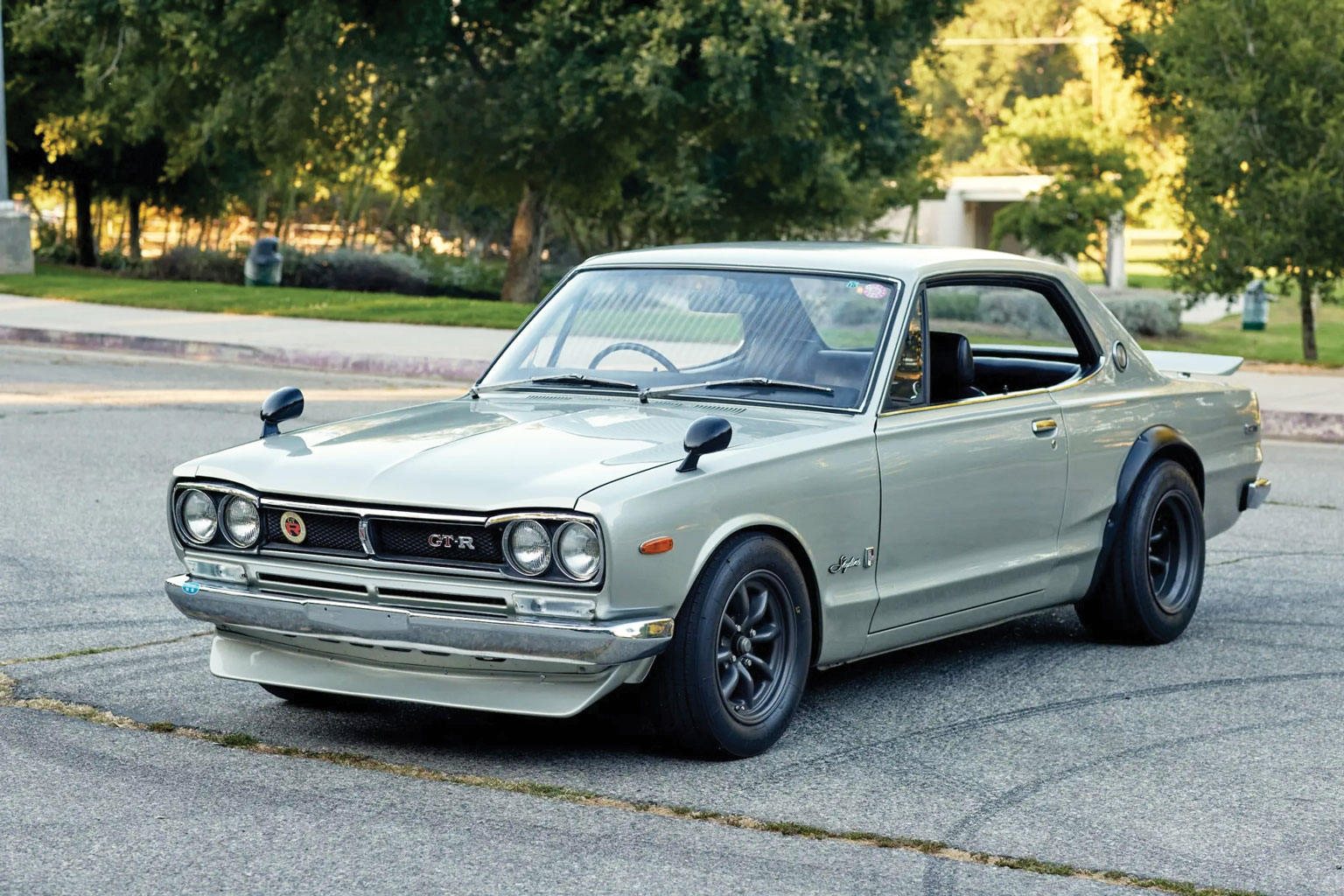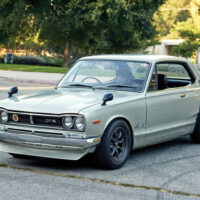This 1971 Nissan Skyline 2000GT-R is said to have remained under long-term ownership in Japan before being imported to the U.S. in 2018, at which time it was acquired by the seller. Finished in silver over black vinyl upholstery, the car is powered by a 2.0-liter S20 inline-6 that features dual overhead camshafts, 24 valves and triple Mikuni Solex carburetors. Additional equipment includes a 5-speed manual transmission, front disc brakes, four-wheel independent suspension, staggered-width 15-inch Watanabe magnesium wheels, Michelin TB15 tires, a limited-slip differential, upgraded sway bars, a tubular exhaust manifold and fixed-back seats.
The car was included in the 2019 Japanese Automotive Invitational at Pebble Beach, CA, and service performed under current ownership involved overhauling the carburetors and replacing the fuel pump, auxiliary oil cooler, radiator and ignition components. This KPGC10 Hakosuka GT-R is now offered in California with spare parts, service records, manufacturer’s literature and a clean South Dakota title in the seller’s name.
SCM Analysis
Detailing
| Vehicle: | 1971 Nissan Skyline 2000GT-R |
| Years Produced: | 1971–72 |
| Number Produced: | 1,115 |
| Tune Up Cost: | $1,000 |
| Chassis Number Location: | VIN tag in left front corner of engine bay, chassis stamped under left inner side sill under inner rocker vinyl |
| Engine Number Location: | Rear of the engine block in line with the center of the valve cover |
| Club Info: | GTR Owners Club |
| Website: | http://www.gtroc.org |
| Alternatives: | 1967–73 Porsche 911S, 1973–75 BMW 2002 Turbo, 1969–73 Isuzu Bellett GT-R |
This car, Lot 122481, sold for $216,000, including buyer’s premium, on Bring a Trailer’s online auction on October 3, 2023.
While Nissan Skylines have been embraced by the enthusiast community in recent years, the model’s history remains little known to many. First- and second-generation Skyline models were built by the Prince Motor Company of Japan. The Skyline name has been credited to Prince’s engineer Shinichiro Sakurai, who coined the term as he observed the crisp skies of the Gunma Prefecture on Japan’s Honshu Island. The earliest first-generation Prince Skylines were 4-door models introduced in April 1957. These well-built machines sported inline 4-cylinder G-series engines, and several examples competed in rallies. The ultimate first-gen Skylines were the Sport Coupe and Sport Convertible, both designed by Giovanni Michelotti and built with hand-formed bodies in Italy.
Second-generation Skylines included 4-door sedans and 5-door station wagons and also primarily used inline 4-cylinder engines. Although these were wonderful driving machines, it was the 6-cylinder S54 2000GT that catapulted the Skyline brand to legendary status. The small company of Prince had set its sights on the 1964 Japan Grand Prix at Suzuka and prepared five 2000GTs with a single purpose: victory. The 2000GTs battled hard, chasing a Porsche 904 GTS much of the race. Arguably the most important moment in Japanese racing history occurred when driver Tetsu Ikuzawa blasted past the 904 entering a tight curve. At that moment the entire stadium and all of Japan stood up and cheered, and the Skyline became a national sensation.
Two years later, Nissan acquired Prince. Going forward, Nissan not only retained the Skyline lineup but produced 11 additional generations, with units built totaling in the millions.
Birth of the GT-R
Whereas Prince was responsible for originating the Skyline family of automobiles, it was Nissan who created the ultimate iteration with the Skyline GT-R (Gran Turismo Racer). Of the 13 generations of Skylines produced over several decades, only five included a Skyline GT-R model.
The original Skyline GT-R was a 4-door sedan produced in 1969 as part of the third-generation (C10) Skyline. In 1971 the C10 Skyline GT-R coupe was introduced. Both sedan and coupe GT-Rs commonly go by the name 2000GT-R “Hakosuka.” This represents a combination of the Japanese words “hako” (box) and “suka” (skyline). The next Skyline GT-R (C110) was introduced in 1972 as part of the fourth-generation cars and commonly goes by the name 2000GT-R “Kenmeri.” Both the Hakosuka and Kenmeri GT-Rs were powered by high-revving DOHC engines.
After a 16-year hiatus, the Skyline GT-R returned in 1989 as part of the eighth generation of Skyline automobiles. These Skyline GT-Rs are known as R32 and were followed by the R33 in 1993 and the R34 in 1999. The R32, R33, and R34 were each powered by the astonishing 2.6-liter twin-turbocharged, DOHC, inline-6 RB26DETT engine. Note that the Nissan GT-R introduced in 2007 was not part of the Skyline family.
From four doors to two
The Hakosuka GT-R coupe followed the sedan in reaching both dealerships and the winner’s podium. In truth, the racing legend of the C10 GT-R was initially earned by the sedans, which scored an astonishing 36 consecutive class victories at Japanese racing circuits between 1969 and 1971. Following the model’s introduction in March 1971, the Hakosuka GT-R coupes piled up an additional 18 class wins. Race after race, these cars were simply unbeatable and created a sense of national pride among the Japanese. The C10 GT-R also launched the Skyline GT-R franchise, making it synonymous with performance, power, technological superiority and winning.
The heart of the 2000GT-R was its race-bred, 2.0-liter, DOHC, inline-6 S20 engine. This was truly an engineering masterwork in its day, with four valves per cylinder and a hemispherical combustion chamber with a crossflow head. Equipped with three carburetors, the S20 produced 160 hp at 7,000 rpm in showroom tune and was capable of much more when race-prepared. A 5-speed manual gearbox and a limited-slip differential helped highlight the car’s performance pedigree. Period reports described the 2000GT-R as one of the quickest production coupes of the time, with a 0–60 mph time of just 8.1 seconds.
As the car was designed to win races, Nissan put a great deal of focus on handling. Four-wheel independent suspension was uncommon in production vehicles of the period, but Nissan understood its importance when road racing at the top level. The car’s competition-tuned suspension included double wishbones up front and independent trailing arms at the rear. Additionally, manual steering and brakes provided the driver with tactile feedback.
Weight savings was a major design element of the Skyline 2000GT-R coupe, with a wheelbase 7 cm shorter than the sedan. Nissan worked in earnest to lighten every aspect of the car’s composition, including stripping down the interior and deleting the radio and heater to produce a curb weight of 2,425 pounds. Although the sedan was the car that initially put the Skyline GT-Rs on the map, the Hakosuka GT-R coupe was lighter, faster, nimbler and had better balance and agility. It remains a true driver’s car, meant to be flung and flogged with heavy use of all three pedals.
A flat market
Our subject car is one of just 1,115 Nissan Skyline 2000GT-R Hakosuka coupes produced between March 1971 and September 1972, with all examples being right-hand drive. The collector-car world generally favors coupes over sedans, and this is the case with the Hakosuka GT-R. The combination of a sportier appearance, shorter wheelbase and improved performance has created a two-times valuation factor for coupes over sedans in the C10 GT-R market.
Interestingly, coupe prices have been relatively flat over the past seven years, with clean, no-stories examples consistently selling between $175,000 and $250,000. From the photographs and auction-house description, our subject Hako GT-R appeared to be a wonderful low-mileage example that sold at a market-correct price, fair for buyer and seller alike. ♦
(Introductory description courtesy of Bring a Trailer.)



